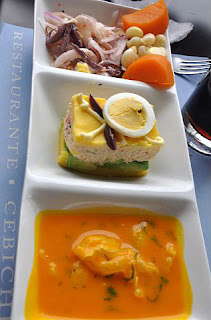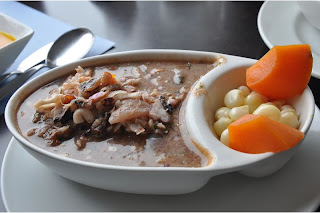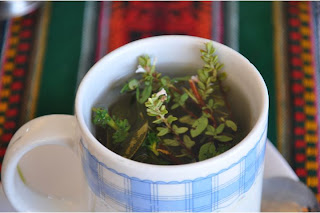Instead of specific restaurants, I am featuring the popular Peruvian dishes in this post.
Ceviche
If you were in Lima, or any other coastal city, you cannot leave without trying ceviche. Traditional ceviche is prepared by marinating diced raw fish (or shellfish) in lime juice and hot peppers and served with raw onions, sweet potato and corn.
Tiradito is a different version of ceviche, influenced by Japanese immigrants who came in the nineteenth century. Fish is sliced (like sashimi) and served without onions. You may find ginger, soy and other Japanese ingredients added to this dish.
Chifa
Chifa is Peruvian Chinese cuisine. The word Chifa supposedly came from the Mandarin words Chi - Fan which means to eat rice. Many Chinese immigrants came in the nineteenth century. Chinese ingredients were hard to find in Peru, so the Chinese incorporated many Peruvian elements into their cuisine. I was suspicious to this at first, but this shellfish chaufa (fried rice) was delicious!
Lomo saltado is the ultimate Peruvian-Chinese fusion dish. Strips of sirloin are marinated in vinegar, soy sauce and spices and then stir fried with red onions, parsley and tomatoes. It is served over white rice with homemade french fries on the side.
Punta Sal in Lima serves great ceviche and chaufa dishes. For more information, visit http://www.puntasal.com/.
Pollo a la Brasa
It is basically Peruvian rotisserie chicken. But the Peruvians have a way of making the meat super juicy and the skin crisp and tasty. The dish usually comes with french fries, salad and various creams (Peruvian mayonnaise, ketchup, olive sauce, chimichurri and aji/chili sauces).
Pardo’s Chicken in Lima is popular among the locals. For more information, visit http://www.pardoschicken.com.pe/ingles/index.asp.
Alpaca
In the Andean region, alpaca meat is very common. It is lean and high in protein, one of the healthiest and most flavorful meat.
Zig Zag in Arequipa serves meats and fish cooked on Volcanic Stone. For more information, visit http://www.zigzagrestaurant.com/eng/restaurant.html.
Trucha
Peruvian trout were introduced from Canada to provide the Andean communities with a much needed boost of protein in their diets. This was one of the tastiest dish I had in Peru.
Cuy
I have to mention cuy, fried guinea pig, because it is an important source of proteins for the poor Andean communities in highlands. It is usually served in whole and quite graphic. I will only include a hidden image for those who are curious and brave.
Sol de Mayo in Arequipa is popular among the locals and serves cuy and other tasty Peruvian cuisine. For more information, visit http://www.restaurantsoldemayo.com/.
Chupe de Camarones
Chupe de camarones (prawn chupe) is quite common in the Arequipa region. It is made from a thick freshwater shrimp (crayfish) stock soup, potatoes, milk and chili pepper.
Rocoto Relleno
Rocoto Relleno, another dish from Arequipa, is stuffed rocoto (chili pepper), usually filled with minced meat, onions, cream and nuts.
Maize
Check out the size of this! Peruvian corn has huge kernels! It is very dense and not very juicy; worth a try though.
Cancha, a popular snack in Peru, is made with maize. The dried kernels are tossed with oil and toasted in a hot skillet until they are browned and puffed. It is quite additive!
Coca tea
Coca tea is made using the leaves of the coca plant and believed to alleviate the symptoms of altitude sickness. Honestly, I was not a fan. It was very oily and tasted like grass.












No comments:
Post a Comment